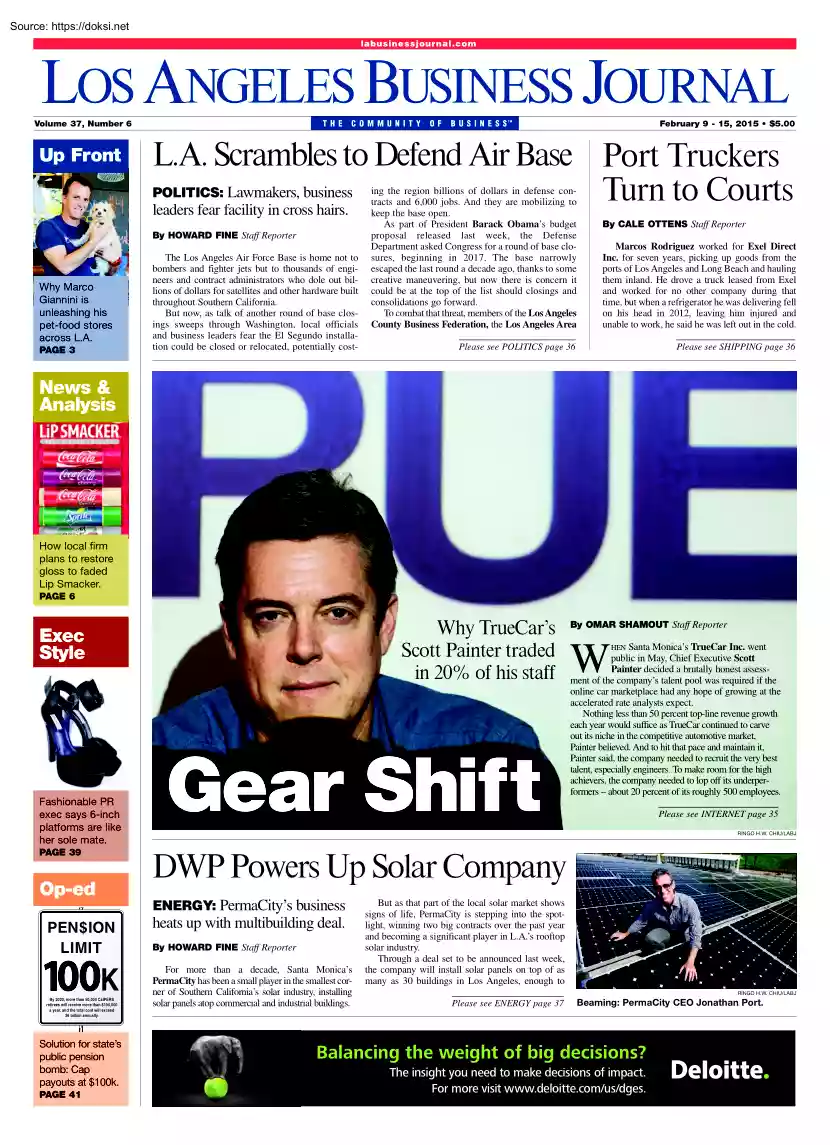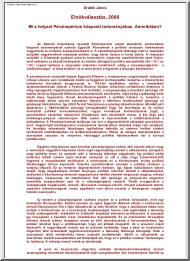Alapadatok
Év, oldalszám:2015, 2 oldal
Nyelv:angol
Letöltések száma:2
Feltöltve:2022. szeptember 15.
Méret:1 MB
Intézmény:
-
Megjegyzés:
LOS ANGELES BUSINESS JOURNAL
Csatolmány:-
Letöltés PDF-ben:Kérlek jelentkezz be!
Értékelések
Nincs még értékelés. Legyél Te az első!Tartalmi kivonat
labusinessjournal.com LOS ANGELES BUSINESS JOURNAL THE Volume 37, Number 6 Up Front COMMUNITY PAGE 3 BUSINESS TM February 9 - 15, 2015 • $5.00 L.A Scrambles to Defend Air Base Port Truckers POLITICS: Lawmakers, business Turn to Courts leaders fear facility in cross hairs. By HOWARD FINE Staff Reporter Why Marco Giannini is unleashing his pet-food stores across L.A OF The Los Angeles Air Force Base is home not to bombers and fighter jets but to thousands of engineers and contract administrators who dole out billions of dollars for satellites and other hardware built throughout Southern California. But now, as talk of another round of base closings sweeps through Washington, local officials and business leaders fear the El Segundo installation could be closed or relocated, potentially cost- ing the region billions of dollars in defense contracts and 6,000 jobs. And they are mobilizing to keep the base open. As part of President Barack Obama’s budget proposal released
last week, the Defense Department asked Congress for a round of base closures, beginning in 2017. The base narrowly escaped the last round a decade ago, thanks to some creative maneuvering, but now there is concern it could be at the top of the list should closings and consolidations go forward. To combat that threat, members of the Los Angeles County Business Federation, the Los Angeles Area By CALE OTTENS Staff Reporter Marcos Rodriguez worked for Exel Direct Inc. for seven years, picking up goods from the ports of Los Angeles and Long Beach and hauling them inland. He drove a truck leased from Exel and worked for no other company during that time, but when a refrigerator he was delivering fell on his head in 2012, leaving him injured and unable to work, he said he was left out in the cold. Please see POLITICS page 36 Please see SHIPPING page 36 News & Analysis How local firm plans to restore gloss to faded Lip Smacker. PAGE 6 Why TrueCar’s Scott Painter traded in 20% of
his staff Exec Style Fashionable PR exec says 6-inch platforms are like her sole mate. PAGE 39 Gear Shift W Santa Monica’s TrueCar Inc. went public in May, Chief Executive Scott Painter decided a brutally honest assessment of the company’s talent pool was required if the online car marketplace had any hope of growing at the accelerated rate analysts expect. Nothing less than 50 percent top-line revenue growth each year would suffice as TrueCar continued to carve out its niche in the competitive automotive market, Painter believed. And to hit that pace and maintain it, Painter said, the company needed to recruit the very best talent, especially engineers. To make room for the high achievers, the company needed to lop off its underperformers – about 20 percent of its roughly 500 employees. HEN Please see INTERNET page 35 RINGO H.W CHIU/LABJ DWP Powers Up Solar Company Op-ed ENERGY: PermaCity’s business PEN$ION LIMIT K By 2020, more than 50,000 CalPERS retirees will
receive more than $100,000 a year, and the total cost will exceed $6 billion annually. Solution for state’s public pension bomb: Cap payouts at $100k. PAGE 41 By OMAR SHAMOUT Staff Reporter heats up with multibuilding deal. By HOWARD FINE Staff Reporter For more than a decade, Santa Monica’s PermaCity has been a small player in the smallest corner of Southern California’s solar industry, installing solar panels atop commercial and industrial buildings. But as that part of the local solar market shows signs of life, PermaCity is stepping into the spotlight, winning two big contracts over the past year and becoming a significant player in L.A’s rooftop solar industry. Through a deal set to be announced last week, the company will install solar panels on top of as many as 30 buildings in Los Angeles, enough to RINGO H.W CHIU/LABJ Please see ENERGY page 37 Beaming: PermaCity CEO Jonathan Port. Balancing the weight of big decisions? The insight you need to make decisions of
impact. For more visit www.deloittecom/us/dges FEBRUARY 9, 2015 LOS ANGELES BUSINESS JOURNAL 37 Energy: DWP Lights Fire Under Solar Company Continued from page 1 generate 22 megawatts of electricity, as part of a contract issued by the Los Angeles Department of Water & Power. It’s one of the biggest deals ever for rooftop solar development in the city. That deal follows one PermaCity reached in the summer to install solar panels on the roof of clothing retailer Forever 21’s headquarters in Lincoln Heights. Activated late last month, the 15,500 panels can generate 5 megawatts of electricity – enough to power nearly 1,450 single-family homes and to make it the largest single commercial rooftop solar installation to date in Los Angeles. PermaCity posted revenue last year of between $20 million and $30 million; over the 18 months of the new contract, Jonathan Port, PermaCity’s founder and chief executive, said he expects revenue to grow by about 40 percent. “This is a
huge deal for any company and is definitely a game-changer, both for us and for Los Angeles,” he said. Lagging market Residential solar rooftop projects have taken off over the last few years, making household names out of residential specialists Verengo Solar in Torrance and SolarCity in San Mateo. But solar development on top of commercial and industrial properties has lagged behind, although SolarCity recently installed a big array on the MillerCoors brewery in Irwindale. (See story, page 8) The amount of power produced by commercial rooftop installations grew by single digits between 2012 and last year, while power produced by residential installation more than doubled in that time, according to Washington trade group Solar Energy Industries Association. A handful of obstacles have kept commercial building owners from joining the solar rush, most notably aging roofs that need to be replaced, said PermaCity’s Port. In the years after the recession, building owners held off on
paying for new roofs and other maintenance projects, and it doesn’t make sense for them to install solar arrays on roofs that will need to be replaced in just a few years. Financing is also problematic, as government incentives for commercial rooftop projects have been sparse and shrinking, despite generous incentives for residential projects. The smaller incentives make it more difficult for building owners to defray the tens or hundreds of thousands of dollars in upfront costs. RINGO H.W CHIU/LABJ Hot Property: PermaCity’s Jonathan Port on the roof of customer Forever 21’s headquarters in Lincoln Heights. But commercial building owners who have been able to get financing have seen solar panels pay off. Chatsworth natural foods maker Earth Island, said that after PermaCity installed solar panels at its building in 2002, the company started making money from selling extra power to the DWP. The roof has 756 panels generating roughly 85 kilowatts of electricity. “When Jonathan
Port first approached me about installing solar, I was a bit dubious,” said Earth Island Chief Executive Robert Goldberg. “But we’ve been cash-flow positive since day one and the system has had no major problems.” Small-scale projects such as Earth Island became the bread and butter for PermaCity and for the commercial solar rooftop industry as a whole. PermaCity has also installed modest-sized solar arrays on American Apparel Inc.’s downtown LA headquarters and an El Monte loan-servicing center for Chinatown’s Cathay Bank. New technology But scaling up to large projects ran up against some technological obstacles: Putting thousands of solar panels on a big-box store or a warehouse typically means lots of added weight and lots of holes drilled into the roof for the brackets that hold panels in place. (Drilled holes, even when sealed, can eventually cause leaks.) In the last couple of years, though, equipment has become much lighter. And PermaCity has developed a system
that doesn’t involve drilling holes in the roof; instead, the systems are welded on. The company used that system for the first time on a large scale on its Forever 21 project. Young Kwon, vice president and general counsel for Forever 21, said the clothing retailer looked at proposals from several firms before choosing PermaCity. Two factors swayed its decision: the high-efficiency SunPower Corp. panels PermaCity uses and the method for power sales. Many installers, both of residential and commercial projects, own the panels and sell power back to their customers at a much cheaper rate than the local utility. But PermaCity said the power generated by the panels belongs to Forever 21. That deal likely helped PermaCity snag the new 22 megawatt deal. On that project, PermaCity is technically a subcontractor; the DWP’s contract is with SunEdison Inc. of St Peters, Mo., which will be building an 88 megawatt solar plant in Kern County to supply power to the municipal agency. Under the
terms of that contract, SunEdison must provide 22 megawatts of rooftop solar power generated within DWP’s service territory. SunEdison put that subcontract out to bid and PermaCity came out the winner. SunEdison will pay PermaCity to find buildings – between 15 and 30 of them – for new rooftop arrays. Building owners will ultimately pay PermaCity for the installations themselves, with financing from SunEdison partner TerraForm Power Inc. of Bethesda, Md. Port said some of the money from SunEdison – he wouldn’t say how much or disclose other terms of the contract – will go to help ramp up production of the parts PermaCity uses to install solar arrays. “This is the first high-volume contract we’ve ever had,” Port said. “Besides jumpstarting the local commercial market, this contract is moving us toward our goal of becoming the largest commercial rooftop solar developer and installer in California and all of the Southwest.” Contracting: Air Force Facility’s Future
up in Air? Continued from page 36 Fuentes. “If the base were to close, some of the contractors ringing the base could shift their own operations elsewhere.” Fuentes works for one of those contractors, Northrop Grumman Corp.’s Redondo Beach Space Park, which makes satellites and other hardware. And Fuentes herself has worked on several of the contracts that have come out of the Los Angeles Air Force Base. She said a big reason the base survived the last round of consolidation in the mid2000s was a land swap. The base had been located in aging buildings in nearby Hawthorne, but local officials convinced the Defense Department and Congress to sell that land and move the base to El Segundo. The sale proceeds were used to pay for a new 545,000-square-foot office campus on the El Segundo base site. Closing a brand-new facility didn’t make much sense, helping keep the base off the closure list, Fuentes said. But, she noted, “we don’t have that option this time.” Still, base
closures aren’t a sure thing, as Congress could prove unwilling to authorize another round of consolidation. According to the article in Air Force Magazine, the last three rounds of consolidation since the mid-1990s have cost roughly $29 billion to implement and are generating only about $1 billion a year in savings, not much of a return on investment. But should base closings be authorized, one factor that could hurt the Los Angeles Air Force Base’s chances of survival is the exit last year of longtime Congressman Henry Waxman. The base is in his old district, which is now represented by freshman Rep. Ted Lieu “Base closing is a very political process,” BizFed’s England said. “And as a member with high seniority, Waxman had the clout to do the horse trading necessary to make sure that the base never got on a closure list.” High Flier: Part of Los Angeles Air Force Base’s campus in El Segundo
last week, the Defense Department asked Congress for a round of base closures, beginning in 2017. The base narrowly escaped the last round a decade ago, thanks to some creative maneuvering, but now there is concern it could be at the top of the list should closings and consolidations go forward. To combat that threat, members of the Los Angeles County Business Federation, the Los Angeles Area By CALE OTTENS Staff Reporter Marcos Rodriguez worked for Exel Direct Inc. for seven years, picking up goods from the ports of Los Angeles and Long Beach and hauling them inland. He drove a truck leased from Exel and worked for no other company during that time, but when a refrigerator he was delivering fell on his head in 2012, leaving him injured and unable to work, he said he was left out in the cold. Please see POLITICS page 36 Please see SHIPPING page 36 News & Analysis How local firm plans to restore gloss to faded Lip Smacker. PAGE 6 Why TrueCar’s Scott Painter traded in 20% of
his staff Exec Style Fashionable PR exec says 6-inch platforms are like her sole mate. PAGE 39 Gear Shift W Santa Monica’s TrueCar Inc. went public in May, Chief Executive Scott Painter decided a brutally honest assessment of the company’s talent pool was required if the online car marketplace had any hope of growing at the accelerated rate analysts expect. Nothing less than 50 percent top-line revenue growth each year would suffice as TrueCar continued to carve out its niche in the competitive automotive market, Painter believed. And to hit that pace and maintain it, Painter said, the company needed to recruit the very best talent, especially engineers. To make room for the high achievers, the company needed to lop off its underperformers – about 20 percent of its roughly 500 employees. HEN Please see INTERNET page 35 RINGO H.W CHIU/LABJ DWP Powers Up Solar Company Op-ed ENERGY: PermaCity’s business PEN$ION LIMIT K By 2020, more than 50,000 CalPERS retirees will
receive more than $100,000 a year, and the total cost will exceed $6 billion annually. Solution for state’s public pension bomb: Cap payouts at $100k. PAGE 41 By OMAR SHAMOUT Staff Reporter heats up with multibuilding deal. By HOWARD FINE Staff Reporter For more than a decade, Santa Monica’s PermaCity has been a small player in the smallest corner of Southern California’s solar industry, installing solar panels atop commercial and industrial buildings. But as that part of the local solar market shows signs of life, PermaCity is stepping into the spotlight, winning two big contracts over the past year and becoming a significant player in L.A’s rooftop solar industry. Through a deal set to be announced last week, the company will install solar panels on top of as many as 30 buildings in Los Angeles, enough to RINGO H.W CHIU/LABJ Please see ENERGY page 37 Beaming: PermaCity CEO Jonathan Port. Balancing the weight of big decisions? The insight you need to make decisions of
impact. For more visit www.deloittecom/us/dges FEBRUARY 9, 2015 LOS ANGELES BUSINESS JOURNAL 37 Energy: DWP Lights Fire Under Solar Company Continued from page 1 generate 22 megawatts of electricity, as part of a contract issued by the Los Angeles Department of Water & Power. It’s one of the biggest deals ever for rooftop solar development in the city. That deal follows one PermaCity reached in the summer to install solar panels on the roof of clothing retailer Forever 21’s headquarters in Lincoln Heights. Activated late last month, the 15,500 panels can generate 5 megawatts of electricity – enough to power nearly 1,450 single-family homes and to make it the largest single commercial rooftop solar installation to date in Los Angeles. PermaCity posted revenue last year of between $20 million and $30 million; over the 18 months of the new contract, Jonathan Port, PermaCity’s founder and chief executive, said he expects revenue to grow by about 40 percent. “This is a
huge deal for any company and is definitely a game-changer, both for us and for Los Angeles,” he said. Lagging market Residential solar rooftop projects have taken off over the last few years, making household names out of residential specialists Verengo Solar in Torrance and SolarCity in San Mateo. But solar development on top of commercial and industrial properties has lagged behind, although SolarCity recently installed a big array on the MillerCoors brewery in Irwindale. (See story, page 8) The amount of power produced by commercial rooftop installations grew by single digits between 2012 and last year, while power produced by residential installation more than doubled in that time, according to Washington trade group Solar Energy Industries Association. A handful of obstacles have kept commercial building owners from joining the solar rush, most notably aging roofs that need to be replaced, said PermaCity’s Port. In the years after the recession, building owners held off on
paying for new roofs and other maintenance projects, and it doesn’t make sense for them to install solar arrays on roofs that will need to be replaced in just a few years. Financing is also problematic, as government incentives for commercial rooftop projects have been sparse and shrinking, despite generous incentives for residential projects. The smaller incentives make it more difficult for building owners to defray the tens or hundreds of thousands of dollars in upfront costs. RINGO H.W CHIU/LABJ Hot Property: PermaCity’s Jonathan Port on the roof of customer Forever 21’s headquarters in Lincoln Heights. But commercial building owners who have been able to get financing have seen solar panels pay off. Chatsworth natural foods maker Earth Island, said that after PermaCity installed solar panels at its building in 2002, the company started making money from selling extra power to the DWP. The roof has 756 panels generating roughly 85 kilowatts of electricity. “When Jonathan
Port first approached me about installing solar, I was a bit dubious,” said Earth Island Chief Executive Robert Goldberg. “But we’ve been cash-flow positive since day one and the system has had no major problems.” Small-scale projects such as Earth Island became the bread and butter for PermaCity and for the commercial solar rooftop industry as a whole. PermaCity has also installed modest-sized solar arrays on American Apparel Inc.’s downtown LA headquarters and an El Monte loan-servicing center for Chinatown’s Cathay Bank. New technology But scaling up to large projects ran up against some technological obstacles: Putting thousands of solar panels on a big-box store or a warehouse typically means lots of added weight and lots of holes drilled into the roof for the brackets that hold panels in place. (Drilled holes, even when sealed, can eventually cause leaks.) In the last couple of years, though, equipment has become much lighter. And PermaCity has developed a system
that doesn’t involve drilling holes in the roof; instead, the systems are welded on. The company used that system for the first time on a large scale on its Forever 21 project. Young Kwon, vice president and general counsel for Forever 21, said the clothing retailer looked at proposals from several firms before choosing PermaCity. Two factors swayed its decision: the high-efficiency SunPower Corp. panels PermaCity uses and the method for power sales. Many installers, both of residential and commercial projects, own the panels and sell power back to their customers at a much cheaper rate than the local utility. But PermaCity said the power generated by the panels belongs to Forever 21. That deal likely helped PermaCity snag the new 22 megawatt deal. On that project, PermaCity is technically a subcontractor; the DWP’s contract is with SunEdison Inc. of St Peters, Mo., which will be building an 88 megawatt solar plant in Kern County to supply power to the municipal agency. Under the
terms of that contract, SunEdison must provide 22 megawatts of rooftop solar power generated within DWP’s service territory. SunEdison put that subcontract out to bid and PermaCity came out the winner. SunEdison will pay PermaCity to find buildings – between 15 and 30 of them – for new rooftop arrays. Building owners will ultimately pay PermaCity for the installations themselves, with financing from SunEdison partner TerraForm Power Inc. of Bethesda, Md. Port said some of the money from SunEdison – he wouldn’t say how much or disclose other terms of the contract – will go to help ramp up production of the parts PermaCity uses to install solar arrays. “This is the first high-volume contract we’ve ever had,” Port said. “Besides jumpstarting the local commercial market, this contract is moving us toward our goal of becoming the largest commercial rooftop solar developer and installer in California and all of the Southwest.” Contracting: Air Force Facility’s Future
up in Air? Continued from page 36 Fuentes. “If the base were to close, some of the contractors ringing the base could shift their own operations elsewhere.” Fuentes works for one of those contractors, Northrop Grumman Corp.’s Redondo Beach Space Park, which makes satellites and other hardware. And Fuentes herself has worked on several of the contracts that have come out of the Los Angeles Air Force Base. She said a big reason the base survived the last round of consolidation in the mid2000s was a land swap. The base had been located in aging buildings in nearby Hawthorne, but local officials convinced the Defense Department and Congress to sell that land and move the base to El Segundo. The sale proceeds were used to pay for a new 545,000-square-foot office campus on the El Segundo base site. Closing a brand-new facility didn’t make much sense, helping keep the base off the closure list, Fuentes said. But, she noted, “we don’t have that option this time.” Still, base
closures aren’t a sure thing, as Congress could prove unwilling to authorize another round of consolidation. According to the article in Air Force Magazine, the last three rounds of consolidation since the mid-1990s have cost roughly $29 billion to implement and are generating only about $1 billion a year in savings, not much of a return on investment. But should base closings be authorized, one factor that could hurt the Los Angeles Air Force Base’s chances of survival is the exit last year of longtime Congressman Henry Waxman. The base is in his old district, which is now represented by freshman Rep. Ted Lieu “Base closing is a very political process,” BizFed’s England said. “And as a member with high seniority, Waxman had the clout to do the horse trading necessary to make sure that the base never got on a closure list.” High Flier: Part of Los Angeles Air Force Base’s campus in El Segundo





 Írásunkban a műelemzések készítésének módszertanát járjuk körül. Foglalkozunk az elemzés főbb fajtáival, szempontjaival és tanácsokat adunk az elemzés legfontosabb tartalmi elemeivel kapcsolatban is. Módszertani útmutatónk főként tanulók számára készült!
Írásunkban a műelemzések készítésének módszertanát járjuk körül. Foglalkozunk az elemzés főbb fajtáival, szempontjaival és tanácsokat adunk az elemzés legfontosabb tartalmi elemeivel kapcsolatban is. Módszertani útmutatónk főként tanulók számára készült!